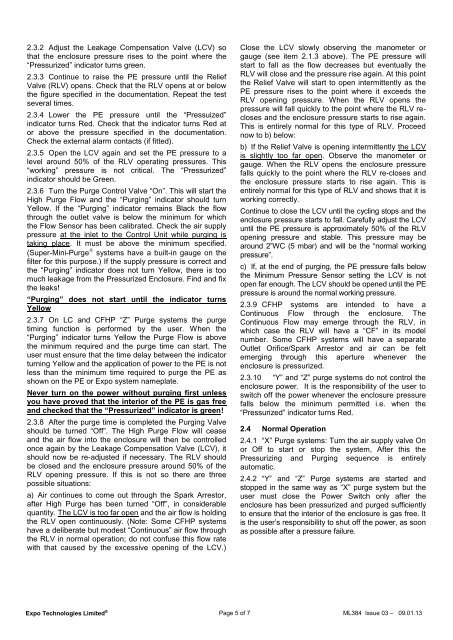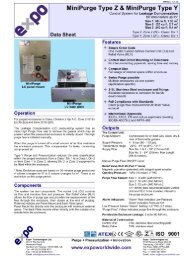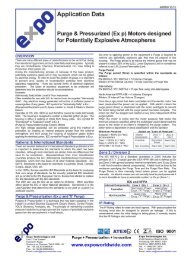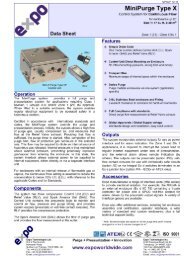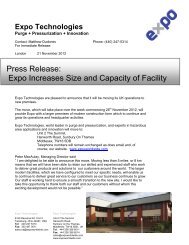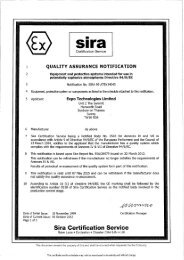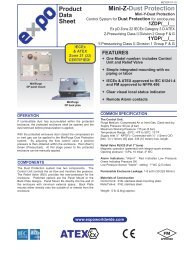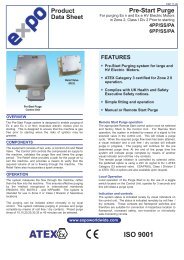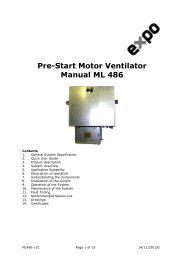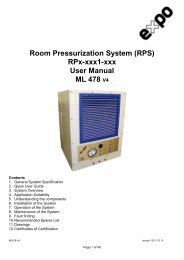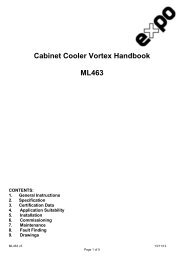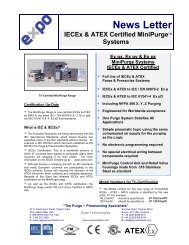Expo-Telektron Safety Systems Ltd - Expo Technologies
Expo-Telektron Safety Systems Ltd - Expo Technologies
Expo-Telektron Safety Systems Ltd - Expo Technologies
Create successful ePaper yourself
Turn your PDF publications into a flip-book with our unique Google optimized e-Paper software.
2.3.2 Adjust the Leakage Compensation Valve (LCV) so<br />
that the enclosure pressure rises to the point where the<br />
“Pressurized” indicator turns green.<br />
2.3.3 Continue to raise the PE pressure until the Relief<br />
Valve (RLV) opens. Check that the RLV opens at or below<br />
the figure specified in the documentation. Repeat the test<br />
several times.<br />
2.3.4 Lower the PE pressure until the “Pressuized”<br />
indicator turns Red. Check that the indicator turns Red at<br />
or above the pressure specified in the documentation.<br />
Check the external alarm contacts (if fitted).<br />
2.3.5 Open the LCV again and set the PE pressure to a<br />
level around 50% of the RLV operating pressures. This<br />
“working” pressure is not critical. The “Pressurized”<br />
indicator should be Green.<br />
2.3.6 Turn the Purge Control Valve “On”. This will start the<br />
High Purge Flow and the “Purging” indicator should turn<br />
Yellow. If the “Purging” indicator remains Black the flow<br />
through the outlet valve is below the minimum for which<br />
the Flow Sensor has been calibrated. Check the air supply<br />
pressure at the inlet to the Control Unit while purging is<br />
taking place. It must be above the minimum specified.<br />
(Super-Mini-Purge � systems have a built-in gauge on the<br />
filter for this purpose.) If the supply pressure is correct and<br />
the “Purging” indicator does not turn Yellow, there is too<br />
much leakage from the Pressurized Enclosure. Find and fix<br />
the leaks!<br />
“Purging” does not start until the indicator turns<br />
Yellow<br />
2.3.7 On LC and CFHP “Z” Purge systems the purge<br />
timing function is performed by the user. When the<br />
“Purging” indicator turns Yellow the Purge Flow is above<br />
the minimum required and the purge time can start. The<br />
user must ensure that the time delay between the indicator<br />
turning Yellow and the application of power to the PE is not<br />
less than the minimum time required to purge the PE as<br />
shown on the PE or <strong>Expo</strong> system nameplate.<br />
Never turn on the power without purging first unless<br />
you have proved that the interior of the PE is gas free<br />
and checked that the “Pressurized” indicator is green!<br />
2.3.8 After the purge time is completed the Purging Valve<br />
should be turned “Off”. The High Purge Flow will cease<br />
and the air flow into the enclosure will then be controlled<br />
once again by the Leakage Compensation Valve (LCV), it<br />
should now be re-adjusted if necessary. The RLV should<br />
be closed and the enclosure pressure around 50% of the<br />
RLV opening pressure. If this is not so there are three<br />
possible situations:<br />
a) Air continues to come out through the Spark Arrestor,<br />
after High Purge has been turned “Off”, in considerable<br />
quantity. The LCV is too far open and the air flow is holding<br />
the RLV open continuously. (Note: Some CFHP systems<br />
have a deliberate but modest “Continuous” air flow through<br />
the RLV in normal operation; do not confuse this flow rate<br />
with that caused by the excessive opening of the LCV.)<br />
Close the LCV slowly observing the manometer or<br />
gauge (see item 2.1.3 above). The PE pressure will<br />
start to fall as the flow decreases but eventually the<br />
RLV will close and the pressure rise again. At this point<br />
the Relief Valve will start to open intermittently as the<br />
PE pressure rises to the point where it exceeds the<br />
RLV opening pressure. When the RLV opens the<br />
pressure will fall quickly to the point where the RLV recloses<br />
and the enclosure pressure starts to rise again.<br />
This is entirely normal for this type of RLV. Proceed<br />
now to b) below:<br />
b) If the Relief Valve is opening intermittently the LCV<br />
is slightly too far open. Observe the manometer or<br />
gauge. When the RLV opens the enclosure pressure<br />
falls quickly to the point where the RLV re-closes and<br />
the enclosure pressure starts to rise again. This is<br />
entirely normal for this type of RLV and shows that it is<br />
working correctly.<br />
Continue to close the LCV until the cycling stops and the<br />
enclosure pressure starts to fall. Carefully adjust the LCV<br />
until the PE pressure is approximately 50% of the RLV<br />
opening pressure and stable. This pressure may be<br />
around 2”WC (5 mbar) and will be the “normal working<br />
pressure”.<br />
c) If, at the end of purging, the PE pressure falls below<br />
the Minimum Pressure Sensor setting the LCV is not<br />
open far enough. The LCV should be opened until the PE<br />
pressure is around the normal working pressure.<br />
2.3.9 CFHP systems are intended to have a<br />
Continuous Flow through the enclosure. The<br />
Continuous Flow may emerge through the RLV, in<br />
which case the RLV will have a “CF” in its model<br />
number. Some CFHP systems will have a separate<br />
Outlet Orifice/Spark Arrestor and air can be felt<br />
emerging through this aperture whenever the<br />
enclosure is pressurized.<br />
2.3.10 “Y” and “Z” purge systems do not control the<br />
enclosure power. It is the responsibility of the user to<br />
switch off the power whenever the enclosure pressure<br />
falls below the minimum permitted i.e. when the<br />
“Pressurized” indicator turns Red.<br />
2.4 Normal Operation<br />
2.4.1 “X” Purge systems: Turn the air supply valve On<br />
or Off to start or stop the system, After this the<br />
Pressurizing and Purging sequence is entirely<br />
automatic.<br />
2.4.2 “Y” and “Z” Purge systems are started and<br />
stopped in the same way as “X” purge system but the<br />
user must close the Power Switch only after the<br />
enclosure has been pressurized and purged sufficiently<br />
to ensure that the interior of the enclosure is gas free. It<br />
is the user’s responsibility to shut off the power, as soon<br />
as possible after a pressure failure.<br />
<strong>Expo</strong> <strong>Technologies</strong> Limited � Page 5 of 7 ML384 Issue 03 – 09.01.13


